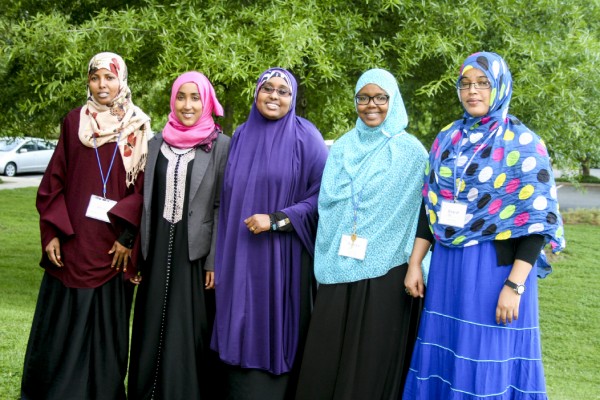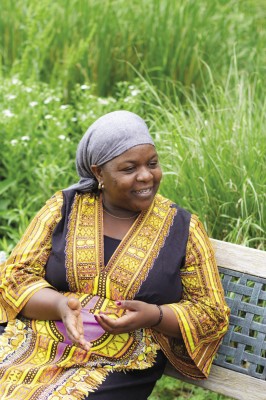
It was a quiet Wednesday on June 19, just five days past the closing session of the 2013 Summer Peacebuilding Institute, when word came of an organized attack on the United Nations Development Programme office in Mogadishu, Somalia.
Jan Jenner, MA ’99, director of the Women’s Peacebuilding Leadership Program at CJP, immediately typed these words in an email subject line – “How are you? You and your colleagues are in our prayers!” – and sent it to two of her program participants, Muslim women employed by the UNDP who had been assigned to that Mogadishu office.
One of the women turned out not to be in Mogadishu, but the other was there. She hid from the al-Shabab attackers and survived the assault, which took the lives of 11, plus all seven of the suicide-style attackers.
President Hassan Sheikh Mohamud of Somalia, a country receiving massive UN support to recover economically and politically after 22 years of warfare and no functioning government, chooses his words carefully amid frequent terrorist attacks aimed at himself and other targets believed to represent stability. While condemning the attacks and comforting the survivors, Mohmaud keeps attention focused on Somalia’s “roadmap to peace” – better education, health care, job creation, and democratic institutions, inclusive of all ethnicities, with full participation of both genders. (Mohamud took three classes in EMU’s 2001 Summer Peacebuilding Institute.)
Being a peacebuilder of any gender in Africa, but especially a woman peacebuilder, is not a cushy line of work. Yet African women are increasingly rising to the challenge. Tecla Wanjala, MA ’03, was the first woman in the world to lead a national truth and reconciliation process. She started as vice chair of Kenya’s Truth and Reconciliation Commission when it was formed in 2008 in the wake of massive election-sparked violence. She served as acting chair when the chairman, a former ambassador, needed to step aside for two years.
The commission had a mandate to address what happened in Kenya between 1963 and 2008 in regard to gross violations of human rights, economic crimes, illegal acquisition of public land, marginalization of communities, ethnic violence, and related issues that continue to plague Kenya.
The resulting report, presented to President Uhuru Kenyatta in May 2013, cataloged a lamentable history of serious human rights violations, from patterns of abuse during British colonial rule to those of each government since independence. Bringing these abuses to light and implicating people who are powerful to this day took courage by Wanjala and her fellow commissioners.

Doreen Ruto: STAR expert in Kenya
The June 2013 terrorist attack on the UN compound in Somalia – followed by one in late September by the same al-Shabab on Westgate, a major shopping mall in Nairobi – aroused painful memories in Doreen Ruto, MA ’06.
When the U.S. Embassy in Nairobi was attacked in 1998, 240 Kenyans died, many working in the Teachers Service Commis- sion building adjacent to the embassy. Ruto’s husband was among the deceased. Ruto decided she could succumb to bitterness and despair – she was left a single mother with two young children – or she could equip herself to address violence nonviolently. So she found her way to CJP, bringing her sons with her. (The older one, Richy Bikko, is a 2011 graduate of EMU.)
Today Ruto is the director of Daima Initiatives for Peace and Development in Kenya, a nationally focused nongovernmental organization she launched in 2010. Her first project, using a UNICEF grant, was “Education for Peace,” aimed at making the voices of young Kenyans heard. For a year and a half, Ruto spent a week with representatives from each of the 47 counties in Kenya, training them how to recognize, tap and foster students’ peace aspirations and skills.
Next, with backing from Mennonite Central Committee, Ruto started “Justice that Heals,” which employs STAR (Strategies for Trauma Awareness and Resilience) methodologies. As a certified STAR trainer, Ruto has been holding workshops for a multiplicity of people traumatized by the Westgate attack: first responders in the security forces, Red Cross staffers, survivors and their caregivers, and media personnel who covered the attack. She is also teaching counselors and religious leaders the skills and strategies they need to foster resilience in their communities.
Her STAR work takes her throughout East Africa and the Great Lakes region. In October 2013, for example, she gave a presentation at the headquarters of the African Union in Ethiopia on how unhealed trauma leads to cycles of violence.
During the height of massive and deadly violence that marked the 2007-08 electoral period in Kenya, Ruto linked up with other peace practitioners, notably George Wachira (then with the Nairobi Peace Initiative, now working for the UNDP in New York), to form Concerned Citizens for Peace.
In their first meeting, about 10 of the 60 persons in the room had a history linking them to CJP and thus to each other. The Concerned Citizens for Peace decided to circulate peace messages – “choose peace and not violence” and “let’s give dialogue a chance” – via cooperating cell phone companies and mass media. They put up a website featuring ways out of the conflict.
Meanwhile, former UN Secretary-General Kofi Annan and leaders from other African countries poured into Kenya to try to stop the violence from escalating and to bring the parties to the negotiating table. Annan invited Hizkias Assefa, a founding father of CJP who teaches each year at SPI, to join the international team as a mediation expert.
Today, Ruto credits Annan not only for leading a crucial and delicate mediation process, but for remaining engaged in the years between 2008 and the next election in 2013, which was conducted in comparative peace.
“Kofi Annan kept checking on us, monitoring us. He made sure that the agreements worked out by the mediation he led were being implemented. He gave us hope, visiting our country, working with us through this five-year period. He even rebuked our national leaders when he felt they were not living up to the agreement they agreed to.”
Anne Nyambura: Large challenges in Sudan
Things come in large doses at the UNDP’s Darfur Community Peace and Stability Fund (DCPSF), ambitiously tasked with building peace in a five-state region in western Sudan where war, disease and starvation have killed up to a half million people since 2003 and displaced another 2.9 million.
Its funding during the current budgetary cycle, 2011-15, is at $40 million, of which $20 million has already been parceled out to fund 27 projects run by 26 partner organizations, including other UN agencies plus international and Sudanese NGOs. And the list of challenges is long, including the many logistical issues of coordinating an undertaking of such scope amid a persistent lack of security throughout much of the region.
In this sort of context, where the work of peacebuilding itself can serve as a new source of conflict, peacebuilding theory that informs “conflict-sensitive” approaches becomes important, said Anne Nyambura, MA ’06, a peacebuilding specialist with the DCPSF. But moving from theory to reality in Darfur can be easier said than done.
“The practice … of [using] scientific methods in conflict assessments and analysis is not always possible,” she says. “Carrying out surveys and utilization of questionnaires is always met with many challenges, ranging from lack of security to logistical issues.”
To work around this, Nyambura and her DCPSF colleagues have organized workshops for their partner organizations to plan strategies for carrying out conflict-sensitive peacebuilding work across Darfur.
In 2012, says Nyambura, this process allowed DCPSF and its partners to identify two major conflicts to focus on: (1) land and water disputes between livestock herders and farmers; (2) land ownership and occupation conflicts pertaining to internally displaced persons.
As indicators of practical successes, Nyambura points to the reopening of some roads and markets, expanding trade between groups previously in conflict, and examples of new approaches being used to resolve land conflicts between farmers and livestock herders, such as “buffer farms” along routes used by herders and land donated for cooperative tilling by women from two groups that had been at odds with each other.